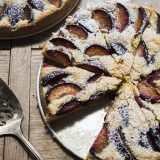My wife’s mother is from Salzburg, so we visit frequently, avoiding the crowd of tourists in front of Mozart’s Geburtshaus and the stores selling large bags of Mozartkugeln (small rounds of nougat and pistachio marzipan coated in dark chocolate).
We do, however, show up in the early evening at the liqueur and wine shop Sporer Likör and order a schnapps spritzer, which is enjoyed standing outside on the sidewalk with locals speaking an almost unintelligible Salzburg dialect. This is usually after a visit to Café Bazar near the Hotel Sacher Salzburg for coffee and a piece of cake.
Cake, or torte, is a relative term when speaking about Austrian cuisine. Many are marvels of pastry, containing a half-dozen or more thin layers with a variety of fillings and glazes: Wiener Nusstorte, Esterházy Torte and Imperial Torte, the last containing multiple layers of cocoa, marzipan, almonds, chocolate, coffee and orange. But Café Bazar also offers simpler desserts, such as Zwetschgenkuchen, or plum cake.
Zwetschgenkuchen has many variations, not just in Austria but in Germany and Eastern Europe as well. Traditionally made as a yeasted cake, Zwetschgenkuchen in its original form is well suited to a cooler season, since it often contains rye flour and is more about the cake than the fruit.
For our summery adaptation, we decided to take a simpler, lighter route and switched from yeast to baking powder. We also upped the butter and used a reverse creaming method. The flour is coated with room-temperature butter before the eggs are added; this prevents gluten formation, keeping the cake light and tender.
While some versions offered a crumb topping, we found it interfered with the fruitiness of the plums. We also tested the cake with a variety of flavorings, including orange zest and brandy, but decided to keep our version clean and simple.
We upped the amount of plums since we wanted this summer dessert to highlight its namesake ingredient. We used 1¼ pounds of plums to 1 cup of flour and ½ cup of sugar. (Both red and black plums worked here, but we also found that an equal amount of Italian prune plums worked in our recipe when cut into halves. Ripe but firm pluots, a plum-apricot hybrid, were another excellent alternative.)
The plums were cut into 3/4-inch wedges, then neatly arranged on their sides on top of the batter in concentric circles. We baked the cake at a low temperature for an hour or slightly more to make sure the batter cooked fully—the plum topping tended to insulate the cake from the oven’s heat.
The result was exactly what we had hoped for—a light, summery take on Zwetschgenkuchen, a cake that served as a simple base for juicy sweet-tart plums. Simple to make and even easier to eat.




